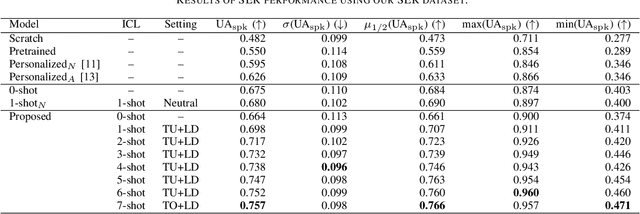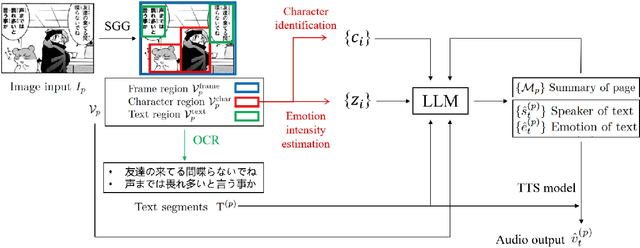speech recognition
Speech recognition is the task of identifying words spoken aloud, analyzing the voice and language, and accurately transcribing the words.
Papers and Code
CS-FLEURS: A Massively Multilingual and Code-Switched Speech Dataset
Sep 17, 2025We present CS-FLEURS, a new dataset for developing and evaluating code-switched speech recognition and translation systems beyond high-resourced languages. CS-FLEURS consists of 4 test sets which cover in total 113 unique code-switched language pairs across 52 languages: 1) a 14 X-English language pair set with real voices reading synthetically generated code-switched sentences, 2) a 16 X-English language pair set with generative text-to-speech 3) a 60 {Arabic, Mandarin, Hindi, Spanish}-X language pair set with the generative text-to-speech, and 4) a 45 X-English lower-resourced language pair test set with concatenative text-to-speech. Besides the four test sets, CS-FLEURS also provides a training set with 128 hours of generative text-to-speech data across 16 X-English language pairs. Our hope is that CS-FLEURS helps to broaden the scope of future code-switched speech research. Dataset link: https://huggingface.co/datasets/byan/cs-fleurs.
Are Multimodal Foundation Models All That Is Needed for Emofake Detection?
Sep 19, 2025In this work, we investigate multimodal foundation models (MFMs) for EmoFake detection (EFD) and hypothesize that they will outperform audio foundation models (AFMs). MFMs due to their cross-modal pre-training, learns emotional patterns from multiple modalities, while AFMs rely only on audio. As such, MFMs can better recognize unnatural emotional shifts and inconsistencies in manipulated audio, making them more effective at distinguishing real from fake emotional expressions. To validate our hypothesis, we conduct a comprehensive comparative analysis of state-of-the-art (SOTA) MFMs (e.g. LanguageBind) alongside AFMs (e.g. WavLM). Our experiments confirm that MFMs surpass AFMs for EFD. Beyond individual foundation models (FMs) performance, we explore FMs fusion, motivated by findings in related research areas such synthetic speech detection and speech emotion recognition. To this end, we propose SCAR, a novel framework for effective fusion. SCAR introduces a nested cross-attention mechanism, where representations from FMs interact at two stages sequentially to refine information exchange. Additionally, a self-attention refinement module further enhances feature representations by reinforcing important cross-FM cues while suppressing noise. Through SCAR with synergistic fusion of MFMs, we achieve SOTA performance, surpassing both standalone FMs and conventional fusion approaches and previous works on EFD.
Identifying and Calibrating Overconfidence in Noisy Speech Recognition
Sep 08, 2025Modern end-to-end automatic speech recognition (ASR) models like Whisper not only suffer from reduced recognition accuracy in noise, but also exhibit overconfidence - assigning high confidence to wrong predictions. We conduct a systematic analysis of Whisper's behavior in additive noise conditions and find that overconfident errors increase dramatically at low signal-to-noise ratios, with 10-20% of tokens incorrectly predicted with confidence above 0.7. To mitigate this, we propose a lightweight, post-hoc calibration framework that detects potential overconfidence and applies temperature scaling selectively to those tokens, without altering the underlying ASR model. Evaluations on the R-SPIN dataset demonstrate that, in the low signal-to-noise ratio range (-18 to -5 dB), our method reduces the expected calibration error (ECE) by 58% and triples the normalized cross entropy (NCE), yielding more reliable confidence estimates under severe noise conditions.
Few-shot Personalization via In-Context Learning for Speech Emotion Recognition based on Speech-Language Model
Sep 10, 2025



This paper proposes a personalization method for speech emotion recognition (SER) through in-context learning (ICL). Since the expression of emotions varies from person to person, speaker-specific adaptation is crucial for improving the SER performance. Conventional SER methods have been personalized using emotional utterances of a target speaker, but it is often difficult to prepare utterances corresponding to all emotion labels in advance. Our idea to overcome this difficulty is to obtain speaker characteristics by conditioning a few emotional utterances of the target speaker in ICL-based inference. ICL is a method to perform unseen tasks by conditioning a few input-output examples through inference in large language models (LLMs). We meta-train a speech-language model extended from the LLM to learn how to perform personalized SER via ICL. Experimental results using our newly collected SER dataset demonstrate that the proposed method outperforms conventional methods.
Behind the Scenes: Mechanistic Interpretability of LoRA-adapted Whisper for Speech Emotion Recognition
Sep 11, 2025Large pre-trained speech models such as Whisper offer strong generalization but pose significant challenges for resource-efficient adaptation. Low-Rank Adaptation (LoRA) has become a popular parameter-efficient fine-tuning method, yet its underlying mechanisms in speech tasks remain poorly understood. In this work, we conduct the first systematic mechanistic interpretability study of LoRA within the Whisper encoder for speech emotion recognition (SER). Using a suite of analytical tools, including layer contribution probing, logit-lens inspection, and representational similarity via singular value decomposition (SVD) and centered kernel alignment (CKA), we reveal two key mechanisms: a delayed specialization process that preserves general features in early layers before consolidating task-specific information, and a forward alignment, backward differentiation dynamic between LoRA's matrices. Our findings clarify how LoRA reshapes encoder hierarchies, providing both empirical insights and a deeper mechanistic understanding for designing efficient and interpretable adaptation strategies in large speech models. Our code is available at https://github.com/harryporry77/Behind-the-Scenes.
Joint Learning using Mixture-of-Expert-Based Representation for Enhanced Speech Generation and Robust Emotion Recognition
Sep 10, 2025Speech emotion recognition (SER) plays a critical role in building emotion-aware speech systems, but its performance degrades significantly under noisy conditions. Although speech enhancement (SE) can improve robustness, it often introduces artifacts that obscure emotional cues and adds computational overhead to the pipeline. Multi-task learning (MTL) offers an alternative by jointly optimizing SE and SER tasks. However, conventional shared-backbone models frequently suffer from gradient interference and representational conflicts between tasks. To address these challenges, we propose the Sparse Mixture-of-Experts Representation Integration Technique (Sparse MERIT), a flexible MTL framework that applies frame-wise expert routing over self-supervised speech representations. Sparse MERIT incorporates task-specific gating networks that dynamically select from a shared pool of experts for each frame, enabling parameter-efficient and task-adaptive representation learning. Experiments on the MSP-Podcast corpus show that Sparse MERIT consistently outperforms baseline models on both SER and SE tasks. Under the most challenging condition of -5 dB signal-to-noise ratio (SNR), Sparse MERIT improves SER F1-macro by an average of 12.0% over a baseline relying on a SE pre-processing strategy, and by 3.4% over a naive MTL baseline, with statistical significance on unseen noise conditions. For SE, Sparse MERIT improves segmental SNR (SSNR) by 28.2% over the SE pre-processing baseline and by 20.0% over the naive MTL baseline. These results demonstrate that Sparse MERIT provides robust and generalizable performance for both emotion recognition and enhancement tasks in noisy environments.
Interpretable Modeling of Articulatory Temporal Dynamics from real-time MRI for Phoneme Recognition
Sep 19, 2025



Real-time Magnetic Resonance Imaging (rtMRI) visualizes vocal tract action, offering a comprehensive window into speech articulation. However, its signals are high dimensional and noisy, hindering interpretation. We investigate compact representations of spatiotemporal articulatory dynamics for phoneme recognition from midsagittal vocal tract rtMRI videos. We compare three feature types: (1) raw video, (2) optical flow, and (3) six linguistically-relevant regions of interest (ROIs) for articulator movements. We evaluate models trained independently on each representation, as well as multi-feature combinations. Results show that multi-feature models consistently outperform single-feature baselines, with the lowest phoneme error rate (PER) of 0.34 obtained by combining ROI and raw video. Temporal fidelity experiments demonstrate a reliance on fine-grained articulatory dynamics, while ROI ablation studies reveal strong contributions from tongue and lips. Our findings highlight how rtMRI-derived features provide accuracy and interpretability, and establish strategies for leveraging articulatory data in speech processing.
Streaming Sequence-to-Sequence Learning with Delayed Streams Modeling
Sep 10, 2025We introduce Delayed Streams Modeling (DSM), a flexible formulation for streaming, multimodal sequence-to-sequence learning. Sequence-to-sequence generation is often cast in an offline manner, where the model consumes the complete input sequence before generating the first output timestep. Alternatively, streaming sequence-to-sequence rely on learning a policy for choosing when to advance on the input stream, or write to the output stream. DSM instead models already time-aligned streams with a decoder-only language model. By moving the alignment to a pre-processing step,and introducing appropriate delays between streams, DSM provides streaming inference of arbitrary output sequences, from any input combination, making it applicable to many sequence-to-sequence problems. In particular, given text and audio streams, automatic speech recognition (ASR) corresponds to the text stream being delayed, while the opposite gives a text-to-speech (TTS) model. We perform extensive experiments for these two major sequence-to-sequence tasks, showing that DSM provides state-of-the-art performance and latency while supporting arbitrary long sequences, being even competitive with offline baselines. Code, samples and demos are available at https://github.com/kyutai-labs/delayed-streams-modeling
Emotion-Aware Speech Generation with Character-Specific Voices for Comics
Sep 18, 2025



This paper presents an end-to-end pipeline for generating character-specific, emotion-aware speech from comics. The proposed system takes full comic volumes as input and produces speech aligned with each character's dialogue and emotional state. An image processing module performs character detection, text recognition, and emotion intensity recognition. A large language model performs dialogue attribution and emotion analysis by integrating visual information with the evolving plot context. Speech is synthesized through a text-to-speech model with distinct voice profiles tailored to each character and emotion. This work enables automated voiceover generation for comics, offering a step toward interactive and immersive comic reading experience.
A Bottom-up Framework with Language-universal Speech Attribute Modeling for Syllable-based ASR
Sep 09, 2025We propose a bottom-up framework for automatic speech recognition (ASR) in syllable-based languages by unifying language-universal articulatory attribute modeling with syllable-level prediction. The system first recognizes sequences or lattices of articulatory attributes that serve as a language-universal, interpretable representation of pronunciation, and then transforms them into syllables through a structured knowledge integration process. We introduce two evaluation metrics, namely Pronunciation Error Rate (PrER) and Syllable Homonym Error Rate (SHER), to evaluate the model's ability to capture pronunciation and handle syllable ambiguities. Experimental results on the AISHELL-1 Mandarin corpus demonstrate that the proposed bottom-up framework achieves competitive performance and exhibits better robustness under low-resource conditions compared to the direct syllable prediction model. Furthermore, we investigate the zero-shot cross-lingual transferability on Japanese and demonstrate significant improvements over character- and phoneme-based baselines by 40% error rate reduction.
 Add to Chrome
Add to Chrome Add to Firefox
Add to Firefox Add to Edge
Add to Edge